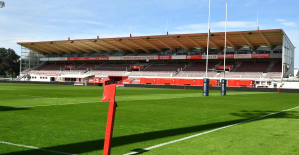Only a few weeks ago, the third observation run of the gravitational wave detectors, Ligo in the US and Virgo in Italy has begun. And the astronomers it has been a struggle, to announce new sensations: in April Alone, 2019 five alleged gravitational wave events in the cosmos have been recorded, with researchers divided on Thursday. One of these vibrations of space-time, so they suspect it was triggered by the collision of a neutron star with a Black hole that has never been observed previously. Another is to relate the second signed ever collision of two neutron stars. The other three were mergers most likely Black holes.
"A Revolution," said the gravitational waves researchers David Reitze on Sunday in a lecture, "is something that changed the way how we think about things." For him, it is therefore a matter of course that, since the first measurement of gravitational waves in the year 2015 is a Revolution in progress. And when you look at how the latest discoveries are included, you have to give him up: If this is not a Revolution, then what?
The results get to the gravitational-wave detectors, Ligo in the USA (in the picture) and Virgo in Italy. Picture: David Ryder/Bloomberg/
Each of the new observations would have added four years ago, half the world in turmoil, in that dark Era before 2015, as they had observed Black holes directly, and gravitational waves were only a theoretical construct. From today's point of view, this era seems so far away as the time of the Black-and-White television. Scientists have become accustomed to the reliability of the Ligo and Virgo sensations provide.
sensitivity increased by 40 percent
For astronomers, gravitational waves have opened it a new window into the universe. Particularly exciting are those collisions in which not only Black holes, but also neutron stars are involved. The latter are the Remains of the burnt-out star with a good one to two solar masses. These objects together also a mass of light, radio waves, x-rays, and Neutrinos bumps send into space.
thanks to the gravitational waves we now know in which direction to handlers, should look with a traditional tele after such radiation. The first time you observed the merger of neutron stars in August 2017, is already managed. For the two new neutron star events, astronomers are still looking for other signals. "Instead of a needle in the haystack we are looking for a needle on a table," said Reitze in his presentation. In other examples, in any case likely to prevail in the future, not a shortage. Since the recent Upgrade of the current monitoring round, the detector has improved sensitivity by a further 40 per cent.
(Tages-Anzeiger)
Created: 02.05.2019, 19:26 PM

 United States: divided on the question of presidential immunity, the Supreme Court offers respite to Trump
United States: divided on the question of presidential immunity, the Supreme Court offers respite to Trump Maurizio Molinari: “the Scurati affair, a European injury”
Maurizio Molinari: “the Scurati affair, a European injury” Hamas-Israel war: US begins construction of pier in Gaza
Hamas-Israel war: US begins construction of pier in Gaza Israel prepares to attack Rafah
Israel prepares to attack Rafah Spain is the country in the European Union with the most overqualified workers for their jobs
Spain is the country in the European Union with the most overqualified workers for their jobs Parvovirus alert, the “fifth disease” of children which has already caused the death of five babies in 2024
Parvovirus alert, the “fifth disease” of children which has already caused the death of five babies in 2024 Colorectal cancer: what to watch out for in those under 50
Colorectal cancer: what to watch out for in those under 50 H5N1 virus: traces detected in pasteurized milk in the United States
H5N1 virus: traces detected in pasteurized milk in the United States Private clinics announce a strike with “total suspension” of their activities, including emergencies, from June 3 to 5
Private clinics announce a strike with “total suspension” of their activities, including emergencies, from June 3 to 5 The Lagardère group wants to accentuate “synergies” with Vivendi, its new owner
The Lagardère group wants to accentuate “synergies” with Vivendi, its new owner The iconic tennis video game “Top Spin” returns after 13 years of absence
The iconic tennis video game “Top Spin” returns after 13 years of absence Three Stellantis automobile factories shut down due to supplier strike
Three Stellantis automobile factories shut down due to supplier strike A pre-Roman necropolis discovered in Italy during archaeological excavations
A pre-Roman necropolis discovered in Italy during archaeological excavations Searches in Guadeloupe for an investigation into the memorial dedicated to the history of slavery
Searches in Guadeloupe for an investigation into the memorial dedicated to the history of slavery Aya Nakamura in Olympic form a few hours before the Flames ceremony
Aya Nakamura in Olympic form a few hours before the Flames ceremony Psychiatrist Raphaël Gaillard elected to the French Academy
Psychiatrist Raphaël Gaillard elected to the French Academy Skoda Kodiaq 2024: a 'beast' plug-in hybrid SUV
Skoda Kodiaq 2024: a 'beast' plug-in hybrid SUV Tesla launches a new Model Y with 600 km of autonomy at a "more accessible price"
Tesla launches a new Model Y with 600 km of autonomy at a "more accessible price" The 10 best-selling cars in March 2024 in Spain: sales fall due to Easter
The 10 best-selling cars in March 2024 in Spain: sales fall due to Easter A private jet company buys more than 100 flying cars
A private jet company buys more than 100 flying cars This is how housing prices have changed in Spain in the last decade
This is how housing prices have changed in Spain in the last decade The home mortgage firm drops 10% in January and interest soars to 3.46%
The home mortgage firm drops 10% in January and interest soars to 3.46% The jewel of the Rocío de Nagüeles urbanization: a dream villa in Marbella
The jewel of the Rocío de Nagüeles urbanization: a dream villa in Marbella Rental prices grow by 7.3% in February: where does it go up and where does it go down?
Rental prices grow by 7.3% in February: where does it go up and where does it go down? Even on a mission for NATO, the Charles-de-Gaulle remains under French control, Lecornu responds to Mélenchon
Even on a mission for NATO, the Charles-de-Gaulle remains under French control, Lecornu responds to Mélenchon “Deadly Europe”, “economic decline”, immigration… What to remember from Emmanuel Macron’s speech at the Sorbonne
“Deadly Europe”, “economic decline”, immigration… What to remember from Emmanuel Macron’s speech at the Sorbonne Sale of Biogaran: The Republicans write to Emmanuel Macron
Sale of Biogaran: The Republicans write to Emmanuel Macron Europeans: “All those who claim that we don’t need Europe are liars”, criticizes Bayrou
Europeans: “All those who claim that we don’t need Europe are liars”, criticizes Bayrou These French cities that will boycott the World Cup in Qatar
These French cities that will boycott the World Cup in Qatar Archery: everything you need to know about the sport
Archery: everything you need to know about the sport Handball: “We collapsed”, regrets Nikola Karabatic after PSG-Barcelona
Handball: “We collapsed”, regrets Nikola Karabatic after PSG-Barcelona Tennis: smash, drop shot, slide... Nadal's best points for his return to Madrid (video)
Tennis: smash, drop shot, slide... Nadal's best points for his return to Madrid (video) Pro D2: Biarritz wins a significant success in Agen and takes another step towards maintaining
Pro D2: Biarritz wins a significant success in Agen and takes another step towards maintaining


















